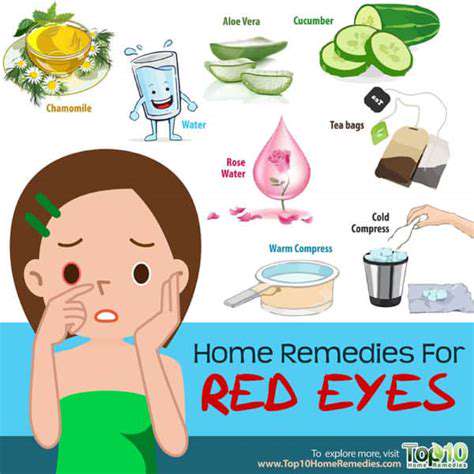Causes and Remedies for Redness Around the Eyes: A Comprehensive Guide
Common Causes of Redness Around the Eyes
Allergic Reactions: A Primary Culprit
Allergies often manifest in various ways, and one of the most common symptoms is redness around the eyes. When exposed to allergens such as pollen, dust mites, or pet dander, the body's immune system can react violently. This reaction can lead to the release of histamines, resulting in inflammation and irritation around the eyes. Recognizing these triggers is vital for effective management.
In individuals who suffer from seasonal allergies, redness may occur cyclically during certain times of the year. The eyes may also water excessively, enhancing the feeling of discomfort. Moreover, those allergic to specific foods or medications can experience similar symptoms, which may further complicate their situation, making it imperative to consult an allergist for testing and advice.
For many, avoiding allergens is a significant step toward relief. However, over-the-counter antihistamines can effectively reduce inflammation and redness. Additionally, utilizing cold compresses can soothe the affected area, providing instant relief from the itchy, burning sensation commonly associated with allergic reactions.
Environmental Factors: Irritants and Pollution
Various environmental factors can contribute to redness around the eyes, particularly irritants such as smoke, pollution, and strong odors. Exposure to these substances can cause significant eye discomfort, leading to a red or inflamed appearance. People living in urban areas or near factories are often more at risk, as air quality can drastically impact eye health.
Moreover, exposure to chlorinated water, commonly found in swimming pools, can exacerbate redness and irritation. Ensuring a clean environment is crucial to minimizing these risks. Using air purifiers at home, refraining from smoking, and avoiding secondhand smoke can greatly improve one’s overall eye health.
Protective eyewear, such as goggles or sunglasses, can also serve as a barrier against environmental irritants. By being mindful of one's surroundings and taking proactive measures, individuals can significantly reduce the incidence of redness around the eyes caused by environmental factors.
Health Conditions: Underlying Issues to Consider
Certain health conditions can lead to persistent redness around the eyes, requiring a thorough examination and treatment. For instance, conditions like blepharitis, which is inflammation of the eyelids, can result in redness and swollen eyelids. This ailment often stems from an overgrowth of bacteria or clogged oil glands and can significantly impact daily life.
Additionally, conditions such as sinusitis can indirectly cause redness around the eyes. The inflammation and pressure associated with sinus issues can lead to discomfort, manifesting as redness. Those experiencing chronic sinus problems may also find their eyes feel heavy or sore, exacerbating the visual symptoms.
It is essential to consult with a healthcare provider when experiencing persistent redness, as underlying health concerns can indicate a more significant issue. Early diagnosis and treatment can prevent complications and restore comfort, ensuring that individuals can enjoy better quality eye health and overall well-being.
Effective Remedies for Redness Around the Eyes

Understanding the Causes of Redness Around the Eyes
Redness around the eyes can arise from a multitude of factors including allergies, infections, or even fatigue. Identifying the root cause is crucial for effective treatment and prevention. Environmental irritants like pollen or dust can exacerbate this issue, leading to discomfort and inflammation.
Another common cause of redness is the misuse of harsh skincare products. When the sensitive skin surrounding the eyes is exposed to these irritants, it may become inflamed. Understanding the different triggers can help individuals take proactive steps to protect their skin.
Home Remedies for Soothing Redness
There are several home remedies that can effectively soothe redness around the eyes. Cold compresses, for example, can decrease inflammation and provide instantaneous relief. A clean cloth soaked in cold water can be applied to the eyelids for about 10-15 minutes to ease swelling.
Another effective remedy is the use of chamomile tea bags. After brewing, chilled tea bags can be placed over the eyes for a period of time. This method not only reduces redness but also has anti-inflammatory properties that can help soothe irritation.
Over-the-Counter Treatments
For those who prefer a more targeted approach, over-the-counter treatments can be very beneficial. Antihistamine eye drops are ideal for individuals suffering from allergies, as they help combat redness and itching. The use of artificial tears can also provide relief by lubricating dry eyes and flushing away irritants.
In addition to eye drops, there are topical creams designed to reduce redness and inflammation. Patients should always read labels carefully and consult with a healthcare professional to ensure the products are suitable for sensitive skin.
Preventive Measures to Avoid Redness
Taking preventive measures is key to minimizing and even avoiding redness around the eyes altogether. Maintaining good hygiene practices, such as regularly washing the face and avoiding touching the eyes, can significantly reduce the risk of irritation. Additionally, staying hydrated and eating a balanced diet rich in vitamins can promote skin health.
Wearing sunglasses can also shield the eyes from harmful UV rays and environmental irritants. Protecting your eyes from sun exposure and pollutants is essential for long-term health. Furthermore, establishing a consistent sleep schedule can aid in reducing fatigue-related redness.
When to Seek Professional Help
While mild redness can often be treated at home, there are times when professional intervention is necessary. If redness persists for an extended period or is accompanied by other symptoms like pain or vision changes, one should consult an eye care specialist promptly. Ignoring these warnings can lead to more severe conditions if left untreated.
Additionally, consulting with a healthcare provider can ensure that any underlying health issues are identified and addressed. Professional guidance is essential for determining the most effective treatment plan tailored to individual needs.